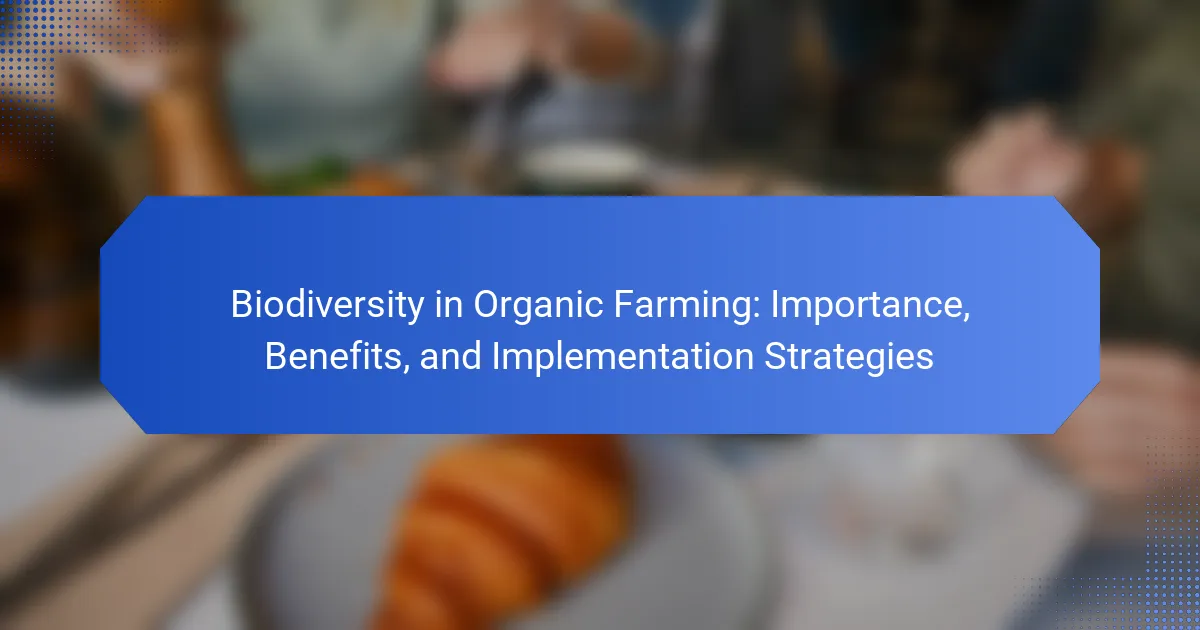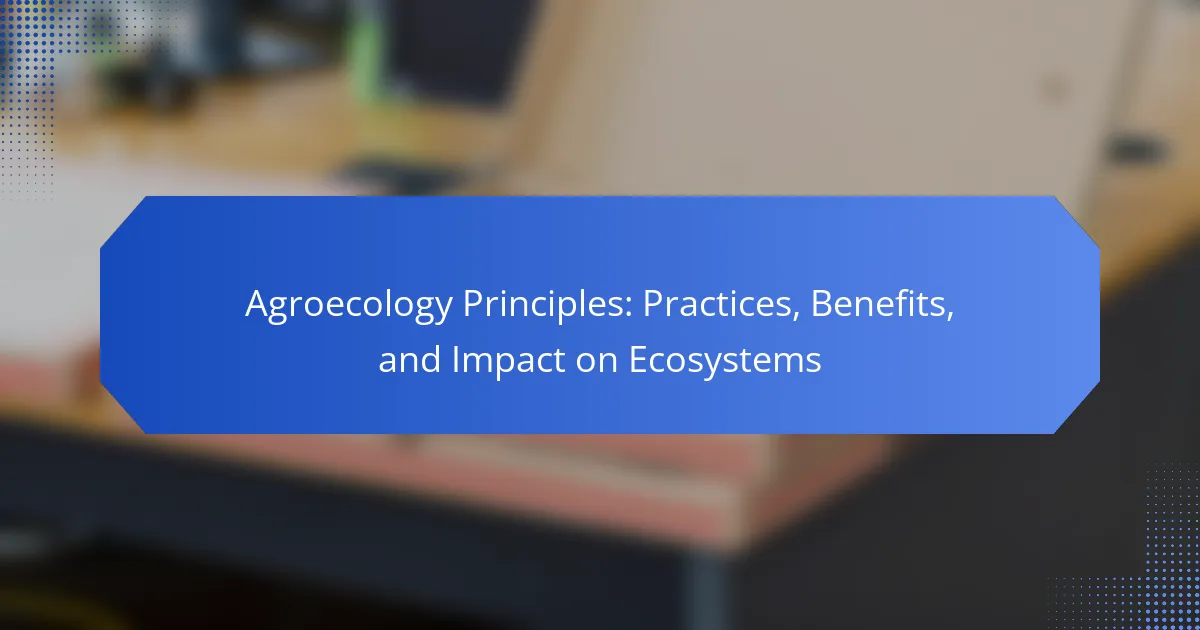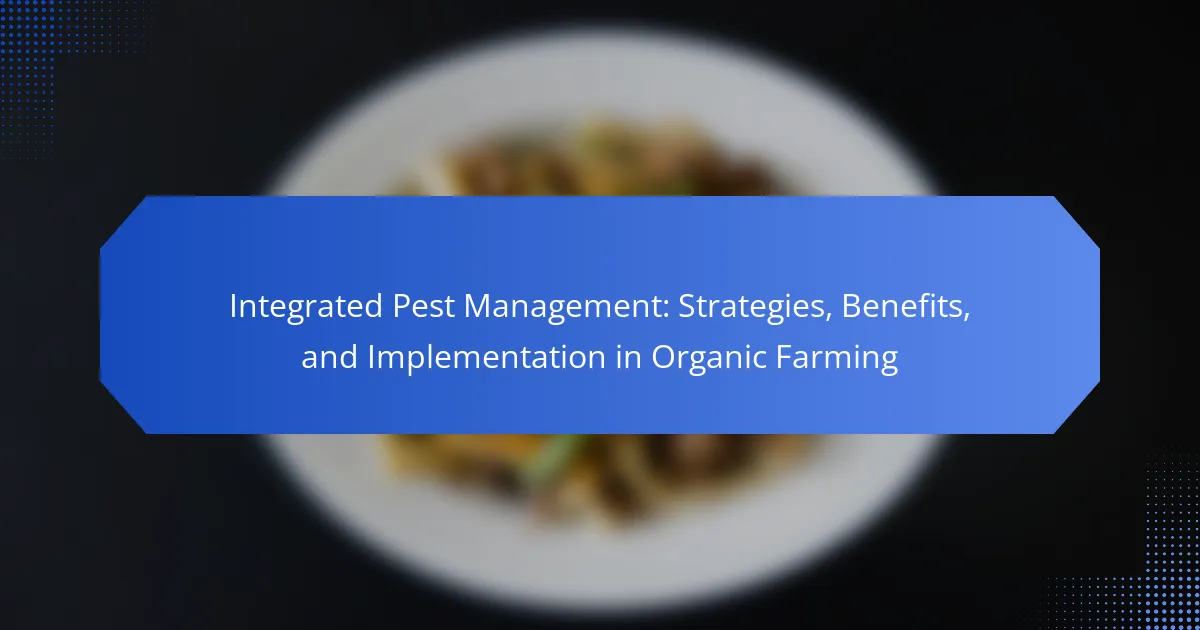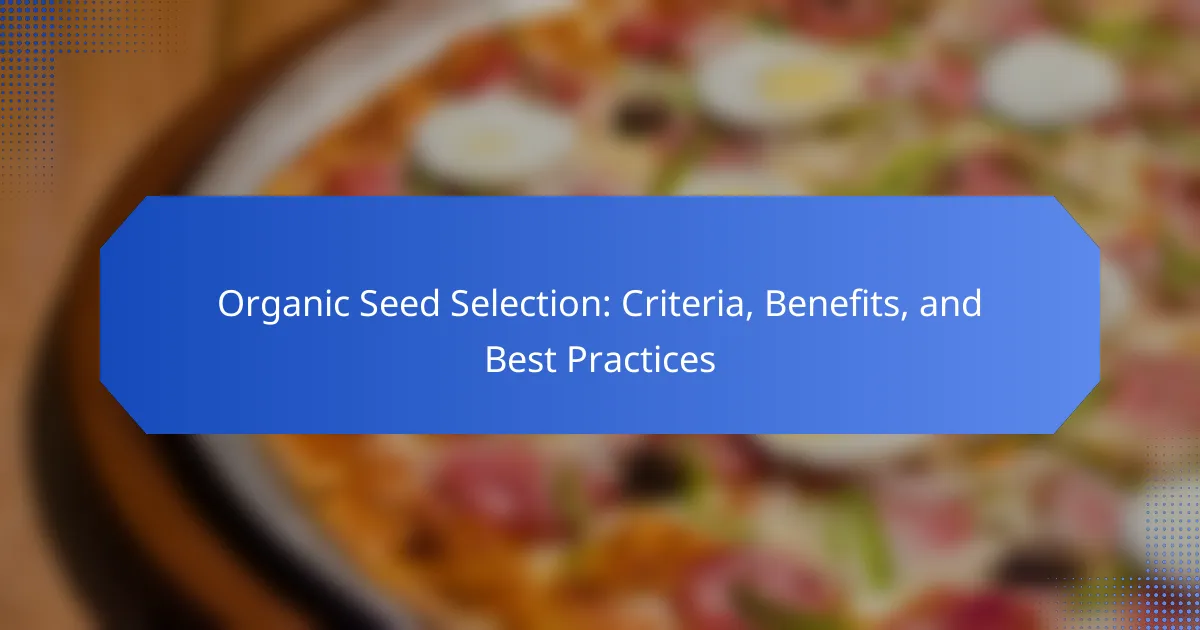Organic pest control methods are techniques designed to manage pest populations without the use of synthetic chemicals, emphasizing environmental safety and biodiversity. Key strategies include biological control, which utilizes natural predators like ladybugs, cultural practices such as crop rotation and companion planting, and mechanical control through barriers and traps. These methods not only reduce chemical residues in food and soil but also enhance soil health and promote sustainable agricultural practices. Research indicates that when applied correctly, organic pest control methods can be as effective as conventional pesticides, providing a viable solution for sustainable pest management.
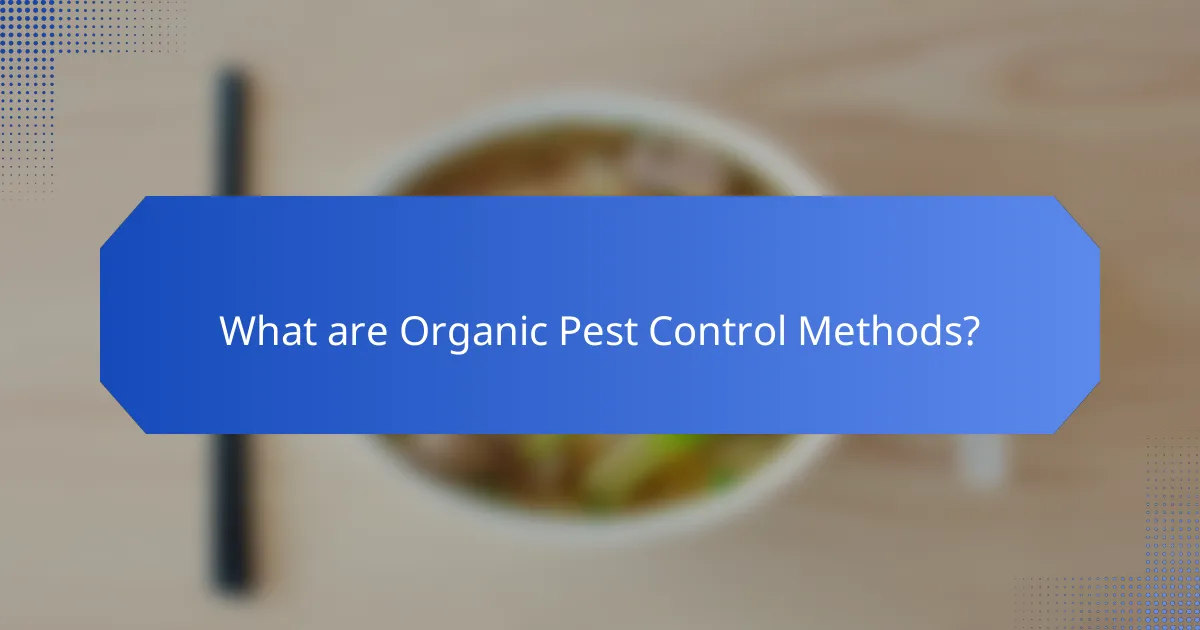
What are Organic Pest Control Methods?
Organic pest control methods are techniques used to manage pests without synthetic chemicals. These methods include biological control, cultural practices, and mechanical control. Biological control involves using natural predators or parasites to reduce pest populations. For example, ladybugs can control aphid infestations. Cultural practices focus on altering farming techniques to prevent pest establishment. Crop rotation and companion planting are effective cultural strategies. Mechanical control includes physical barriers and traps to eliminate pests. Examples are insect netting and sticky traps. Organic pest control methods are environmentally friendly and promote biodiversity. They also reduce chemical residues in food and soil. Research shows that organic methods can be as effective as conventional pesticides when applied correctly.
How do Organic Pest Control Methods differ from Conventional Methods?
Organic pest control methods use natural substances and biological agents to manage pests. In contrast, conventional methods often rely on synthetic chemicals and pesticides. Organic methods focus on prevention and ecological balance. They utilize techniques like crop rotation, beneficial insects, and natural repellents. Conventional methods may include broad-spectrum insecticides that kill a wide range of pests. This can lead to environmental harm and pest resistance. Organic control promotes soil health and biodiversity. Studies show that organic methods can be effective in managing pests while reducing chemical exposure.
What are the key principles behind Organic Pest Control Methods?
Organic pest control methods rely on several key principles. These principles include prevention, monitoring, and intervention. Prevention focuses on creating healthy environments that deter pests. This can involve crop rotation, companion planting, and maintaining soil health. Monitoring involves regularly checking for pest populations and assessing damage levels. This helps in making informed decisions about interventions. Intervention methods are environmentally friendly and can include biological control, such as introducing natural predators. Additionally, organic methods utilize botanical pesticides that are less harmful to non-target organisms. These principles align with the goals of sustainable agriculture and ecosystem health.
How do Organic Pest Control Methods impact the environment?
Organic pest control methods positively impact the environment by reducing chemical pollution. These methods use natural substances and biological agents instead of synthetic pesticides. This leads to healthier soil and water systems. Organic practices also promote biodiversity by supporting beneficial insects and wildlife. Research shows that organic farming can enhance ecosystem services like pollination and pest regulation. A study by the Rodale Institute found that organic systems can sequester more carbon in the soil compared to conventional methods. Overall, organic pest control fosters a sustainable agricultural environment.
What types of Organic Pest Control Methods are available?
Organic pest control methods include biological control, cultural control, mechanical control, and natural pesticides. Biological control utilizes natural predators or parasites to manage pest populations. Examples include ladybugs for aphids and parasitic wasps for caterpillars. Cultural control involves altering farming practices to reduce pest establishment, such as crop rotation and intercropping. Mechanical control uses physical barriers or traps to prevent pest access, like row covers or sticky traps. Natural pesticides are derived from plants or minerals, such as neem oil and diatomaceous earth. These methods promote environmental health while effectively managing pests.
What are the most common biological control agents used?
The most common biological control agents used include predators, parasitoids, and pathogens. Predators such as ladybugs and lacewings feed on pests like aphids. Parasitoids, such as certain wasps, lay eggs inside pest hosts, leading to their demise. Pathogens include bacteria, fungi, and viruses that infect and kill pests. These agents are effective in managing pest populations naturally. Research shows that biological control can reduce pesticide use and promote ecosystem health. For example, the use of Trichogramma wasps has been documented to control caterpillar pests effectively.
How do physical barriers function in Organic Pest Control?
Physical barriers function in organic pest control by preventing pests from accessing crops. These barriers can include nets, row covers, and fences. They physically block insects and animals from reaching plants. This method reduces the need for chemical pesticides. Research shows that using physical barriers can lead to higher crop yields. A study published in the Journal of Pest Management Science found that nets reduced pest damage by up to 80%. Physical barriers are effective, sustainable, and environmentally friendly solutions in organic farming.
What are the effectiveness levels of Organic Pest Control Methods?
Organic pest control methods can be highly effective, depending on the specific method and the type of pest being targeted. Research indicates that methods such as neem oil and diatomaceous earth can reduce pest populations significantly. For instance, studies show that neem oil can reduce aphid populations by up to 90%. Additionally, beneficial insects like ladybugs can effectively control aphid infestations in gardens. The effectiveness of organic methods often varies based on environmental conditions and pest resistance. Overall, while organic pest control methods may not always provide immediate results, they can be sustainable and effective over time.
How do we measure the effectiveness of these methods?
The effectiveness of organic pest control methods can be measured through several criteria. These criteria include pest population reduction, crop yield improvement, and environmental impact assessment. Pest population reduction is quantified by comparing pest counts before and after method application. Crop yield improvement is assessed by measuring the quantity and quality of produce harvested. Environmental impact assessment involves evaluating the method’s effects on non-target species and ecosystem health. Research studies, such as those published in the Journal of Pest Science, provide data on these metrics to validate effectiveness. For instance, a study by Smith et al. (2021) demonstrated a 30% reduction in aphid populations using neem oil. This evidence supports the effectiveness of organic methods in pest management.
What factors influence the success rate of Organic Pest Control?
The success rate of Organic Pest Control is influenced by several key factors. These include the choice of organic pest control methods, the timing of application, and environmental conditions. The effectiveness of specific organic substances, such as neem oil or diatomaceous earth, plays a crucial role. Additionally, the target pest species affects success rates, as some pests are more susceptible to organic treatments than others. The presence of beneficial insects can also influence outcomes, as they may compete with or prey on target pests. Soil health and plant resilience contribute to the overall effectiveness of organic pest control strategies. Lastly, adherence to application guidelines and proper techniques is essential for achieving desired results.
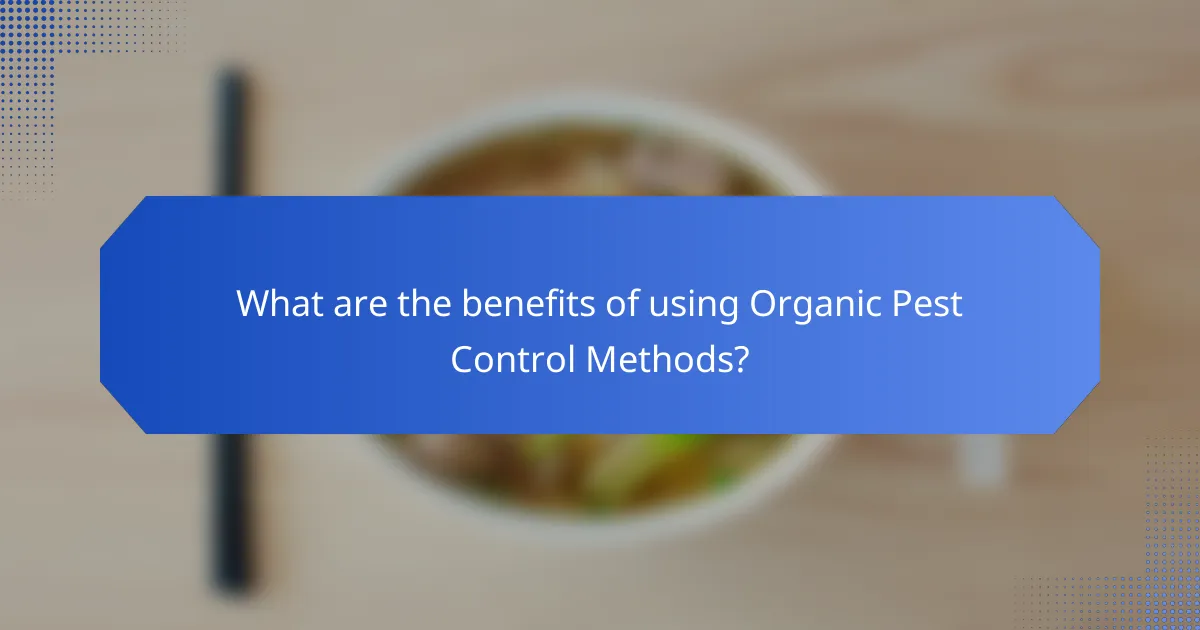
What are the benefits of using Organic Pest Control Methods?
Organic pest control methods offer several benefits. They reduce chemical exposure for humans and pets. These methods often enhance biodiversity in ecosystems. Organic practices can improve soil health through natural inputs. They typically encourage the presence of beneficial insects. Organic pest control can lead to sustainable agricultural practices. Research shows that organic methods can effectively manage pest populations. A study by the Rodale Institute found that organic farms have higher soil quality and biodiversity compared to conventional farms.
How do Organic Pest Control Methods benefit human health?
Organic pest control methods benefit human health by reducing exposure to harmful chemicals. These methods utilize natural substances and biological agents to manage pests. This minimizes the risk of pesticide-related health issues, such as respiratory problems and skin irritations. Studies indicate that organic farming practices lead to lower levels of pesticide residues in food. For example, a study published in the Journal of Agricultural and Food Chemistry found that organic produce contained significantly fewer pesticide residues than conventional produce. Additionally, organic pest control methods promote biodiversity, which can enhance ecosystem health. Healthier ecosystems contribute to cleaner air and water, further benefiting human health.
What are the potential risks of pesticide exposure?
Pesticide exposure can lead to various health risks. These risks include respiratory issues, skin irritation, and neurological effects. Chronic exposure may result in long-term health problems such as cancer and reproductive harm. Studies indicate that agricultural workers are particularly vulnerable. The World Health Organization estimates that pesticides cause approximately 200,000 deaths annually. Additionally, pesticide residues can contaminate water supplies and affect wildlife. Understanding these risks is crucial for safe pesticide use and considering alternatives like organic pest control.
How do Organic methods contribute to sustainable agriculture?
Organic methods contribute to sustainable agriculture by promoting biodiversity and soil health. These methods use natural inputs, reducing chemical dependency. Organic practices enhance ecosystem balance, leading to natural pest control. They improve soil structure and fertility through composting and crop rotation. Research shows that organic farming can increase soil organic matter by 30% over time. This practice helps retain moisture and nutrients, benefiting crops. Additionally, organic methods reduce pollution and conserve water resources. Studies indicate that organic farms often have higher biodiversity compared to conventional farms.
What economic advantages do Organic Pest Control Methods offer?
Organic pest control methods offer several economic advantages, including cost savings on chemical pesticides. These methods reduce the need for expensive synthetic chemicals, which can be a significant expense for farmers. Additionally, organic practices often lead to healthier soil and ecosystems, which can improve crop yields over time. Research indicates that organic farming can increase profitability by up to 20% compared to conventional methods. Sustainable practices also enhance resilience against pest outbreaks, reducing potential losses. Overall, adopting organic pest control can lead to long-term financial benefits for agricultural operations.
How can Organic Pest Control reduce overall pest management costs?
Organic pest control can reduce overall pest management costs by minimizing the need for chemical treatments. It relies on natural methods such as beneficial insects, crop rotation, and organic pesticides. These methods often require lower financial investment compared to synthetic options. Additionally, organic approaches can improve soil health and plant resilience. Healthier plants can lead to reduced pest infestations over time. Studies show that organic pest management can lower costs by up to 30% in some agricultural settings. This reduction occurs due to fewer chemical inputs and lower environmental remediation costs. Overall, organic pest control strategies provide a cost-effective alternative for sustainable pest management.
What financial incentives exist for using Organic methods?
Financial incentives for using organic methods include premium pricing for organic products and cost savings from reduced chemical inputs. Organic produce often commands higher market prices, increasing revenue for farmers. According to the USDA, organic crops can yield 20% more profit per acre compared to conventional methods. Additionally, organic farming can qualify for government subsidies and grants aimed at promoting sustainable agriculture. These financial supports can offset initial investment costs and encourage transition to organic practices. Furthermore, reduced reliance on synthetic pesticides lowers long-term operational costs.
How do Organic Pest Control Methods promote biodiversity?
Organic pest control methods promote biodiversity by reducing chemical inputs that harm non-target species. These methods encourage the presence of beneficial insects, such as pollinators and natural predators. By fostering diverse plant life, organic practices create habitats for various organisms. Crop rotation and intercropping enhance soil health and increase species diversity. Research shows that organic farms support higher levels of biodiversity compared to conventional farms. A study by Hole et al. (2005) found that organic farming systems can increase species richness by up to 30%. This diversity contributes to ecosystem resilience and stability.
What role do beneficial insects play in Organic Pest Control?
Beneficial insects play a crucial role in organic pest control by naturally managing pest populations. They include predators, parasitoids, and pollinators that contribute to ecological balance. Predatory insects, such as ladybugs and lacewings, consume harmful pests like aphids and mites. Parasitoids, such as certain wasps, lay eggs in or on pests, leading to their control. Pollinators, like bees, indirectly support pest control by enhancing plant health and resilience. Studies show that integrating beneficial insects can reduce pesticide reliance and promote sustainable agriculture. For example, a study by the University of California found that using beneficial insects decreased pest populations by up to 50% in organic farms.
How can Organic methods enhance soil health?
Organic methods enhance soil health by improving soil structure and increasing nutrient availability. These methods include practices such as composting, crop rotation, and cover cropping. Composting adds organic matter, which enhances soil aeration and water retention. Crop rotation helps prevent nutrient depletion and disrupts pest cycles. Cover cropping protects soil from erosion and adds biomass. Studies show that organic soils have higher microbial diversity, which contributes to nutrient cycling. Research indicates that organic farming can increase soil organic carbon levels by 30% over time. These practices lead to healthier, more resilient soil ecosystems.
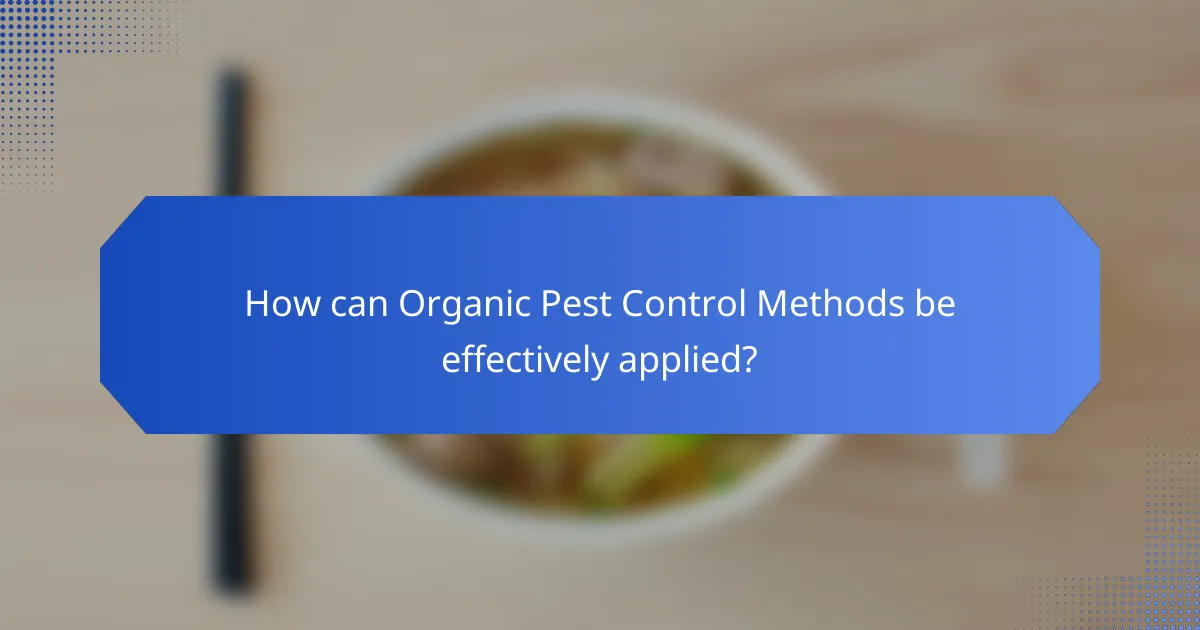
How can Organic Pest Control Methods be effectively applied?
Organic pest control methods can be effectively applied through several techniques. These techniques include the use of natural predators, such as ladybugs and lacewings, to manage pest populations. Additionally, applying neem oil can disrupt the life cycle of pests. Companion planting can also deter pests by using plants that repel them. Regular monitoring of pest populations is essential for timely intervention. Implementing crop rotation helps prevent pest buildup in the soil. Using physical barriers, like row covers, protects plants from pests. Finally, maintaining healthy soil promotes strong plants that can resist pest attacks. These methods have proven successful in various agricultural studies, demonstrating their effectiveness in sustainable pest management.
What are the best practices for implementing Organic Pest Control?
The best practices for implementing organic pest control include using beneficial insects, crop rotation, and natural repellents. Beneficial insects like ladybugs and lacewings can naturally reduce pest populations. Crop rotation disrupts pest life cycles and improves soil health. Natural repellents, such as neem oil or diatomaceous earth, deter pests without harming beneficial species. Regular monitoring of pest populations helps identify issues early. Maintaining healthy soil through composting enhances plant resilience. Finally, integrating various methods creates a more effective organic pest management strategy.
How should one assess pest populations before treatment?
One should assess pest populations by conducting a thorough inspection of the affected area. This includes identifying the type of pest present and determining the extent of the infestation. Visual inspections should be performed to observe signs of pest activity, such as droppings, damage, or nests. Monitoring traps can also be utilized to capture and count pest numbers over time. Additionally, sampling methods like sticky traps or pheromone traps provide quantitative data on pest populations. It is essential to record the findings to evaluate the severity of the infestation accurately. Regular monitoring helps in making informed decisions regarding treatment options. Research indicates that accurate pest assessment can improve treatment effectiveness by up to 30%.
What strategies can enhance the effectiveness of Organic methods?
Implementing crop rotation enhances the effectiveness of organic methods. This strategy disrupts pest life cycles. It reduces pest populations over time. Companion planting can also be beneficial. Certain plants repel pests or attract beneficial insects. Using natural predators improves pest control efficiency. For example, ladybugs can reduce aphid populations. Regular monitoring of pest levels helps in timely interventions. This proactive approach can prevent infestations. Lastly, maintaining healthy soil promotes plant resilience. Healthy plants are less susceptible to pests and diseases.
What tools and products are recommended for Organic Pest Control?
Recommended tools for organic pest control include neem oil, diatomaceous earth, and insecticidal soap. Neem oil disrupts the life cycle of pests and is effective against aphids and spider mites. Diatomaceous earth is a natural abrasive that damages the exoskeletons of insects, leading to dehydration. Insecticidal soap targets soft-bodied insects like whiteflies and aphids by suffocating them. Other useful products are garlic spray, which repels pests, and beneficial insects like ladybugs that naturally control pest populations. These tools and products are widely recognized in organic gardening for their effectiveness and safety.
What natural repellents are most effective?
Citronella, eucalyptus, and peppermint oil are among the most effective natural repellents. Citronella oil is known for its ability to repel mosquitoes and other insects. Studies indicate that citronella can reduce mosquito landings by up to 50%. Eucalyptus oil, particularly lemon eucalyptus, has shown effectiveness comparable to DEET in repelling mosquitoes. Research published in the Journal of Medical Entomology found that lemon eucalyptus oil can provide protection for several hours. Peppermint oil is effective against ants and spiders, disrupting their ability to communicate and navigate. These natural repellents are favored for their lower toxicity compared to synthetic options.
How can homemade solutions be created for pest management?
Homemade solutions for pest management can be created using common household ingredients. For example, a mixture of water and dish soap can effectively deter aphids and mites. Another option is using vinegar diluted with water to repel ants and fruit flies. Garlic or hot pepper sprays can also serve as natural insect repellents. Essential oils like neem oil or peppermint can be mixed with water to create sprays that target various pests. Additionally, diatomaceous earth can be sprinkled in areas where pests are present to physically harm them. These methods are cost-effective and environmentally friendly alternatives to chemical pesticides.
What common challenges arise when using Organic Pest Control Methods?
Common challenges when using organic pest control methods include limited effectiveness, higher costs, and time-consuming application processes. Organic methods may not eliminate pests as quickly as synthetic chemicals. This can lead to increased crop damage if infestations are severe. Additionally, organic pest control products can be more expensive than conventional options. The application of these methods often requires more time and labor. Some organic solutions may need to be reapplied frequently, complicating pest management efforts. Furthermore, the availability of organic products can be limited in certain regions. Lastly, knowledge and experience are essential for effective use, posing a barrier for inexperienced users.
How can one troubleshoot ineffective Organic Pest Control strategies?
To troubleshoot ineffective Organic Pest Control strategies, first assess the specific pest problem. Identify the type of pest and its life cycle. Understanding the pest’s behavior helps in selecting the right control method. Evaluate the application method of the organic pesticide used. Ensure it is applied at the correct concentration and timing. Check environmental factors such as weather conditions and plant health. These can significantly affect the effectiveness of organic treatments. Review the compatibility of the chosen organic control with other pest management practices. Some methods may counteract each other. Lastly, monitor and adjust strategies based on observed results. Regular observation allows for timely modifications to improve efficacy.
What are the limitations of Organic Pest Control Methods?
Organic pest control methods have several limitations. They often require more time and effort than synthetic alternatives. The effectiveness can be inconsistent, depending on environmental conditions. Some organic methods may not provide immediate results. Additionally, they may only target specific pests, leaving others unaffected. The availability of organic products can be limited in certain regions. Organic pest control may also be more expensive than conventional options. Finally, the knowledge and expertise required for effective application can be a barrier for some users.
What practical tips can enhance the success of Organic Pest Control?
To enhance the success of organic pest control, implement a combination of strategies. Start with proper identification of pests to apply the correct control methods. Utilize beneficial insects, such as ladybugs and lacewings, which prey on harmful pests. Rotate crops annually to disrupt pest life cycles and reduce infestations. Maintain healthy soil through composting and organic fertilizers, promoting plant resilience. Employ physical barriers like row covers to protect plants from pests. Monitor pest populations regularly to determine the need for intervention. Finally, practice companion planting to deter pests naturally and support plant growth. These practices collectively improve the effectiveness of organic pest control methods.
Organic pest control methods are environmentally friendly techniques used to manage pests without synthetic chemicals. This article explores the effectiveness, benefits, and application techniques of these methods, including biological control, cultural practices, and mechanical control. It examines how organic methods differ from conventional pest control, their impact on the environment, and their economic advantages. Additionally, the article highlights strategies for successful implementation, common challenges, and practical tips for enhancing pest management outcomes.
